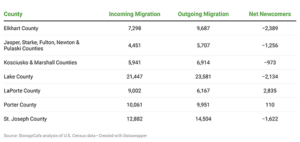Editor's note: Because of an error in StorageCafe's data analysis, a recent story inaccurately reported net migration trends for counties in Northwest and North Central Indiana. Here is the corrected information, provided by StorageCafe.
Experts at StorageCafe analyzed 2022 U.S. Census data and found that Northwest and North Central Indiana counties experienced mixed net migration.
“LaPorte and Porter counties saw positive net migration, with La Porte welcoming over 2,800 newcomers in 2022 and Porter winning over 100-plus residents,” the analysis said.

Overall in 2022, more than 10,00 people moved to Indiana, which put it at No. 18 for interstate migration in the nation. Total population for the state is estimated at 6.8 million. Illinois residents moved to Indiana more than any other state.
Of the 12 counties included in the analysis, the majority of new residents came from other towns in Indiana. The counties considered in the analysis were: Lake, Porter, La Porte, St. Joseph, Elkhart, Newton, Jasper, Starke, Pulaski, Marshall, Kosciusko and Fulton.
La Porte County saw 2,835 new residents, who reported an annual average income of more than $47,000. Millennials reportedly made up 36% of newcomers. Incoming migration was reported at 9,002, with outgoing migration at 6,167.
“The housing market in La Porte might be particularly attractive for them, with the home value in the area standing at an affordable $167,000, as per U.S. Census data,” StorageCafe anlaysts said.
In Porter County, incoming migration topped 10,000 people, but lost 9,951 residents.
Generation Z accounts for an influx of new residents in St. Joseph county; however data showed 12,882 people moving to the county, while 14,504 people moved out.
“The presence of major universities in the area likely contributes to the trend, as recent graduates opt to stay put, while young people from other parts of the country pursue graduate and postgraduate studies here,” analysts said.
StorageCafe used data from the U.S. Census American Community Survey Five-Year PUMS microdata for 2022 in its analysis. The company is a nationwide listing service with more than 25,000 storage facilities listed.
Source of graphic: StorageCafe analysis of data from U.S. Census / Created with Datawrapper with OpenStreetMap contributors




